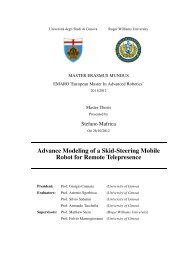East Bay Coalition for the Homeless - Roger Williams University
East Bay Coalition for the Homeless - Roger Williams University
East Bay Coalition for the Homeless - Roger Williams University
You also want an ePaper? Increase the reach of your titles
YUMPU automatically turns print PDFs into web optimized ePapers that Google loves.
What is <strong>the</strong> Board’s perception of how aware people in RI are of <strong>the</strong> EBCH<br />
What is <strong>the</strong> Board’s perception of what people in RI know about <strong>the</strong> EBCH and its programs<br />
What is <strong>the</strong> Board’s perception of how people in RI evaluate <strong>the</strong> EBCH<br />
What is known about donors (past, current, & repeat)<br />
What activities might increase donors and donations<br />
How well known (in RI) are EBCH board members<br />
To what extent are EBCH board members perceived to be community leaders<br />
To what extent are EBCH board members identified with <strong>the</strong> EBCH<br />
What is <strong>the</strong> level of personal relevance of <strong>the</strong> EBCH to board members<br />
What do board members think about current EBCH fundraising activities<br />
What are board preferences <strong>for</strong> additional/different fundraising activities<br />
Survey Development<br />
We designed a survey <strong>for</strong> distribution to <strong>the</strong> EBCH and EBCAP board members. Using <strong>the</strong> Qualtrics online survey<br />
plat<strong>for</strong>m, we created an anonymous survey of with 29 questions grouped into five topic areas.<br />
Roles of current or <strong>for</strong>mer EBCH and EBCAP board members<br />
How established <strong>the</strong> organization is in <strong>the</strong> community<br />
Awareness of <strong>the</strong> EBCH and perceptions of its image<br />
What <strong>the</strong> most effective messages would be <strong>for</strong> telling <strong>the</strong> EBCH “story”<br />
In<strong>for</strong>mation about fundraising ef<strong>for</strong>ts<br />
To avoid bias in responses, questions that might be taken as sensitive were constructed using accepted protocols. For<br />
example, instead of directly asking about EBCH weaknesses, <strong>the</strong> question was phrased to make it acceptable to suggest<br />
areas that might need improvement.<br />
We collaborated with an honors junior service–learning class to construct <strong>the</strong> narratives that were presented in <strong>the</strong><br />
“most effective messages” section. Students in this course investigated homelessness in Rhode Island and wrote six<br />
potential narratives. We refined that set to <strong>the</strong> four that were tested in <strong>the</strong> survey.<br />
We remained in contact with <strong>the</strong> Director while developing <strong>the</strong> survey to make sure that we were on track and that<br />
<strong>the</strong> questions were appropriate <strong>for</strong> <strong>the</strong> board members. The survey was fielded only after <strong>the</strong> Director approved both<br />
<strong>the</strong> survey and <strong>the</strong> email invitation wording.<br />
Survey Distribution<br />
The survey link was emailed to 28 board members, 13 current and <strong>for</strong>mer EBCH board members and <strong>the</strong> 15 members<br />
of <strong>the</strong> EBCAP board (two board members were provided paper copies). Survey respondents were ensured anonymity<br />
and confidentiality.<br />
51
















